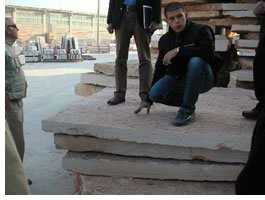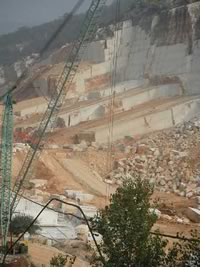
 Four
AIA members who attended an October 1–6 course in Verona, Italy,
on architectural stone applications all came back with fond recollections.
Offered by Veronafiere with cosponsors Stone World and the Italian Trade
Commission, the seminar was held concurrently with Marmomacc, the International
Exhibition of Marble, Stone, and Technology. The seminars were informative,
the attendees concurred, but the real learning happened away from the
classroom. Here's what they said when we asked:
Four
AIA members who attended an October 1–6 course in Verona, Italy,
on architectural stone applications all came back with fond recollections.
Offered by Veronafiere with cosponsors Stone World and the Italian Trade
Commission, the seminar was held concurrently with Marmomacc, the International
Exhibition of Marble, Stone, and Technology. The seminars were informative,
the attendees concurred, but the real learning happened away from the
classroom. Here's what they said when we asked:
What did you learn by going to Italy for continuing education that you
wouldn't have learned at a similar course in your own city?
Winslow C. Kosior, AIA
Pei Cobb Freed and Partners LLP, New York City
I've had more experience with stone in my 23 years with Pei Cobb Freed
than what was offered in these seminars. So for me, from a purely technical
standpoint, the seminars were more like Stone 101. We've done so many
stone buildings that the attachment of stone to structures is something
with which we are very familiar. Some of the other people there had less
background dealing with stone, maybe only in tile, so they learned a lot.
What was certainly worthwhile about the program was going to the quarries and fabrication facilities. The Verona Fair was also interesting with all the equipment and machinery and the stone in blocks and slabs. It was a big eye opener.
 I
had the opportunity to talk to several stone-fabricator representatives.
I concentrated on Spain, because we are currently working on the Torre
Espacio in Madrid. I hadn't realized what a large producer of stone Spain
is. Being able to talk to these people was particularly valuable to me.
I
had the opportunity to talk to several stone-fabricator representatives.
I concentrated on Spain, because we are currently working on the Torre
Espacio in Madrid. I hadn't realized what a large producer of stone Spain
is. Being able to talk to these people was particularly valuable to me.
Perhaps if CES providers got more information on people's background, their seminars could be catered more to people with either more or less experience. That said, I would like to find other programs such as this—in Carrara, for example, because I haven't been all the way up to the quarries there.
Patrick Leahy, AIA
HDR Architecture Inc., Omaha
Being there in Italy is great because you can visit the country, the cities,
and the quarries and see where and how they make these materials. The
actual seminar sessions, which ran from 7 a.m. to almost midnight, could
have been done here. But they also showed us everything from Palladian
villas to modern buildings of stone right there in the city. We saw the
processes from the quarrying to finishing and sculpting. Afterward they
gave us the presentations on CDs so we could review them in more detail
when we got home. In hindsight, it might have been nice to get the CDs
before we left home so we could preview them and have more time to tour.
Another nice thing about going to Italy for continuing education is that it gave me a reason to go see all the architectural cities and places that I had always wanted to see. I planned another week over there to tour the country. I'd been wanting to go forever, and it kind of pushed me over. I may never get back again, so this was a great experience.
The opportunity for making contacts was also good, with other U.S. architects, designers from other parts of the world, and Italian suppliers and artisans. I met a stone consultant from Brazil and one from China. I met people from the Italian Trade Commission and a couple of architects from Canada.
 Seeing
the quarries was really great, because I'd never been to one. I wished
I would have had more time to go to the Marmomacc exhibition, though.
It was huge. Half was for people who quarry and half for material suppliers.
They had stone from tiles to slabs and blocks and everything you can imagine
made with it. You could have spent the entire three days and still not
seen everything in there. It would be worth a trip just to go to that
stone conference. If you're going to use stone, you probably want to get
one of these stone consultants involved because they know where to get
what you need, what it costs, and what it's properties are. You might
even learn more than going to a seminar, since you can pick and choose
the things you want to see and learn. You might not get any continuing
education credits for it, though.
Seeing
the quarries was really great, because I'd never been to one. I wished
I would have had more time to go to the Marmomacc exhibition, though.
It was huge. Half was for people who quarry and half for material suppliers.
They had stone from tiles to slabs and blocks and everything you can imagine
made with it. You could have spent the entire three days and still not
seen everything in there. It would be worth a trip just to go to that
stone conference. If you're going to use stone, you probably want to get
one of these stone consultants involved because they know where to get
what you need, what it costs, and what it's properties are. You might
even learn more than going to a seminar, since you can pick and choose
the things you want to see and learn. You might not get any continuing
education credits for it, though.
Jay Lee, Assoc. AIA
Shepley Bulfinch Richardson and Abbott, Boston
Seeing first-hand the cultural differences is what made a trip to Italy
worth my while. For example, one of the main things I learned is that
the Italians think about masonry the same way we think about wood. I wouldn't
have appreciated that connection without going there and seeing how they
use the material and how they work with it. Even the tools are reminiscent
of woodworking tools, although at a much larger scale.
Then there's all the history that goes along with Italy that you wouldn't necessarily get here. In reality, I suppose someone could put together a good continuing education course on stone architecture right here in Boston. Because I live here, though, it's easy not to pay attention to the things we have in this city.
I got to meet some good people there, too. We are planning on pooling our photographs and distributing them to everyone who attended. That hasn't happened yet because you tend to get back to work and get busy. It was fun.
John Lesak, AIA
Page and Turnbull, Inc., San Francisco
We spent a lot of time on the move, which is a little bit different than
an American continuing education program. We were constantly going from
place to place to see different things. We toured quite a few manufacturing
plants, the quarries, a sculptor's studio, and a mosaic studio. The courses
I've experienced here in the United States tend to be more classroom-oriented,
with a lecturer and a slide projector.
I have a specialty of rehabilitating and restoring historic façades. One of the things that's always real difficult in rehabilitation projects is finding a modern way to recreate something that was done by hand 100 years ago. The skills are either gone or very few people have them. So it was interesting to see all these different tools—diamond blades and wires—and technologies that are more modern and available, yet still have the appearance I need.
I've already been in touch with one manufacturer I met while in Italy. I needed to find a particular color of red marble, and I saw some that might work when I was there. The supplier had a nice display of all kinds of different marble. They gave me a piece of the one that looked like the red I needed. I brought it back, took it to the building, and sure enough, it was what I was looking for. So from that standpoint, it was fantastic.
Copyright 2002 The American Institute of Architects. All rights reserved.
![]()
|
Photos by Jay Lee, Assoc. AIA. To search the hundreds of AIA/CES Provider continuing education opportunities by date, location, or title, go to the AIA.org CES Web page. Happy to stay at home and learn? Here are courses you can take online via the AIA eClassroom. Visit Marmomacc online to get a virtual stone products exhibition. |
|